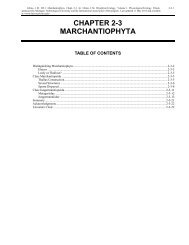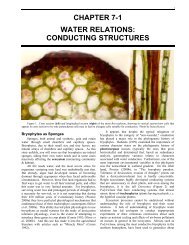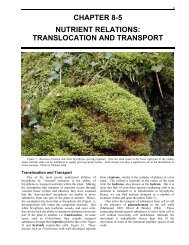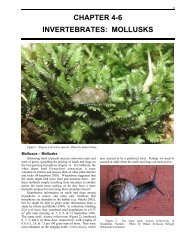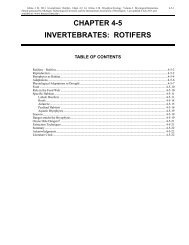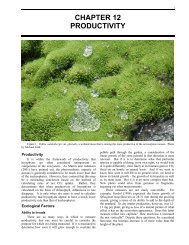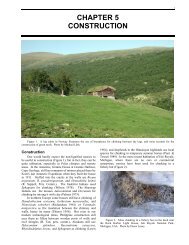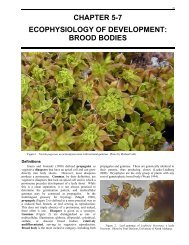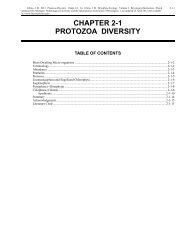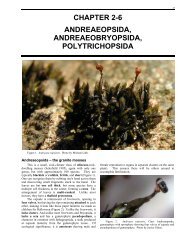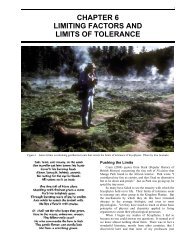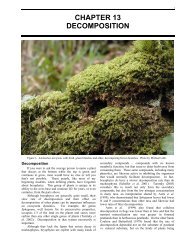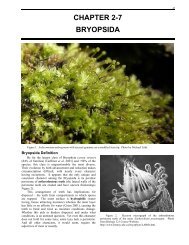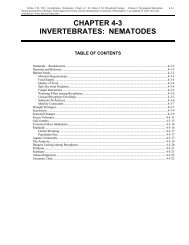chapter 8-3 nutrient relations: nitrogen - Bryophyte Ecology ...
chapter 8-3 nutrient relations: nitrogen - Bryophyte Ecology ...
chapter 8-3 nutrient relations: nitrogen - Bryophyte Ecology ...
You also want an ePaper? Increase the reach of your titles
YUMPU automatically turns print PDFs into web optimized ePapers that Google loves.
22 Chapter 8-3: Nutrient Relations: Nitrogen<br />
Stewart (1968) found that most N fixation occurs at<br />
temperatures above 10°C, thus explaining the lack of<br />
activity in the Smith and Ashton study. Temperatures in<br />
the moss-Cyanobacterial associations in summer in the<br />
maritime Antarctic typically are in excess of 10°C, often<br />
reaching 20°C during midday (Huntley 1971). Smith<br />
(1984) found that the fixation rate increased at<br />
temperatures from –5°C to a maximum at 25-27°C,<br />
decreasing sharply after that. Saturation occurred at ~1000<br />
µmol m -2 s -1 photon flux density, decreasing at higher<br />
levels. Once suitable temperatures were available,<br />
moisture seemed to be the most important criterion, causing<br />
an increase in fixation up to the highest water content<br />
measured: 3,405%! The chemical conditions suitable for<br />
fixation seem to be restrictive, with an optimum pH in this<br />
system of 5.9-6.2 and a negative response to the addition of<br />
P, Co, or Mo (Smith 1984). Hence, under warmer<br />
conditions, fourteen out of nineteen bryophyte associations<br />
did indeed exhibit fixation, with values increasing as<br />
moisture content increased (Smith & Russell 1982). Rates<br />
ranged from 0.36 to 310.57 nmol C2H2 g -1 d m h -1 among<br />
the fourteen with measurable fixation.<br />
In the Arctic soils of Svalbard, Norway, N fixation by<br />
both free-living and bryophyte associations of<br />
Cyanobacteria is the only significant source of N input to<br />
the soil ecosystem (Solheim et al. 1996). The most<br />
important bryophytes for harboring such associations were<br />
Calliergon richardsonii and Sanionia uncinata. An<br />
interesting factor in the fixation was grazing by geese.<br />
Grazed areas had a 10-fold maximum fixation (693.6±1.5<br />
nmol C2H4 h -1 gdm -1 ) compared to ungrazed areas<br />
(65.3±16.6 nmol C2H4 h -1 gdm -1 ), perhaps because in these<br />
areas the Cyanobacteria also occurred on the grass. The<br />
transfer of fixed N to the plants supported high plant<br />
productivity. On the other hand, where birds harbored<br />
under cliffs, the concentration of bird droppings inhibited N<br />
fixation.<br />
The alpine zone likewise is <strong>nitrogen</strong> limited due to the<br />
slow decay rate and limited organic layer. Cyanobacteria<br />
are important in binding the soil and in providing reduced<br />
N. In the subalpine zone of the White Mountains of New<br />
Hampshire, USA, the moss Plagiomnium cuspidatum<br />
provides a suitable habitat for Cyanobacteria (Lambert &<br />
Reiners 1979). On Mt. Fuji, the moss communities of the<br />
dry SW slope are nearly devoid of N-fixing activity, but on<br />
the moist NE-facing cliffs they exhibit high activity,<br />
especially with Nostoc colonies (Nakatsubo & Ohtani<br />
1991), again demonstrating the importance of moisture. In<br />
the somewhat less severe climate of the Alaskan blue<br />
spruce taiga system, feather mosses such as Pleurozium<br />
schreberi and Hylocomium splendens are important<br />
substrates for N-fixing aerobic and facultative anaerobic<br />
bacteria (Billington & Alexander 1983).<br />
But the importance of the Cyanobacteria and other Nfixing<br />
micro-organisms is not limited to such cold<br />
environments. N fixation by Cyanobacterial associations<br />
with bryophytes may be important in many ecosystems<br />
where it has hardly been recognized (Cullimore & McCann<br />
1972; Madhusoodanan & Dominic 1996). In rainforests,<br />
epiphyllous liverworts provide the moist microhabitat<br />
needed for high rates of <strong>nitrogen</strong> fixation by associated<br />
bacteria and Cyanobacteria (Bentley & Carpenter 1980;<br />
Bentley 1987; Carpenter 1992), which may be transferred<br />
to the host leaves (Bentley & Carpenter 1984). In<br />
cryptogamic crusts (i.e. soil crusts of algae, lichens,<br />
bryophytes, and micro-organisms; Figure 15) of prairies,<br />
deserts, and grasslands, Cyanobacteria are able to maintain<br />
an active state longer when water is held by the bryophytes.<br />
This increases their contribution to the usable N in the soil<br />
(Vlassak et al. 1973; Giddens 1982; Belknap et al. 2001).<br />
The crust itself is vital to maintaining both water and<br />
<strong>nutrient</strong>s in the soil during and following heavy storms. In<br />
geothermal fields and following fires, bryophytes again<br />
provide the moist environment needed to maintain N-fixing<br />
micro-organisms (Brasell et al. 1986). Hence, we must ask<br />
if the bryophytes are net users of <strong>nitrogen</strong>, or do they<br />
facilitate a net gain to the system. At least in some habitats<br />
they definitely facilitate a gain by providing the right<br />
habitat for fixation to occur.<br />
Figure 15. Cryptogamic crust with the moss Syntrichia<br />
inermis. Photo by Lloyd Stark.<br />
Although moss associates are responsible for most N<br />
fixation in Arctic and subarctic ecosystems, legume<br />
associations are considered the predominant N fixers in<br />
temperate ecosystems (Stewart 1967). Nevertheless, in<br />
some temperate habitats bryophytes are the only plants able<br />
to occupy the habitat. For example, on granite outcrops,<br />
bryophytes, especially Grimmia/Schistidium, are well<br />
known for their role in accumulating soil and <strong>nutrient</strong>s and<br />
holding the moisture needed for tracheophyte<br />
establishment. Microbial <strong>nitrogen</strong> fixation on these<br />
bryophytes is part of this successional story (Snyder &<br />
Wullstein 1973a; Jones & Wilson 1978). Likewise,<br />
bryophyte-Cyanobacteria associations are important in the<br />
colonization of volcanic lava. Cyanobacteria are common<br />
on bryophytes of dry lava fields (Englund 1976) as well as<br />
on the moist, warm bryophyte surfaces near steam vents<br />
(Broady et al 1987). Both Anabaena variabilis and Nostoc<br />
muscorum were associated with Funaria hygrometrica on<br />
the newly formed volcano Surtsey off the Icelandic coast<br />
(Rodgers & Henriksson 1976). Although the Funaria did<br />
not directly affect the fixation rate, growth of both the<br />
Funaria and the Cyanobacteria benefitted by the<br />
association, and the N content of Funaria also increased as<br />
a result of the cyanobacterial N fixation.<br />
Thus, as in the Arctic, temperate bryophytes often have<br />
associated Cyanobacteria, especially Nostoc. Soil<br />
associations with bryophytes can benefit the ecosystem in<br />
several ways. Not only do they provide additional usable N<br />
to the ecosystem, as in the Gymnostomum recurvirostrum



